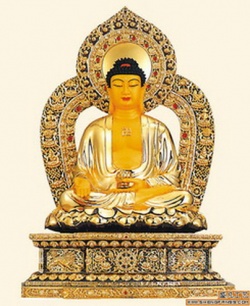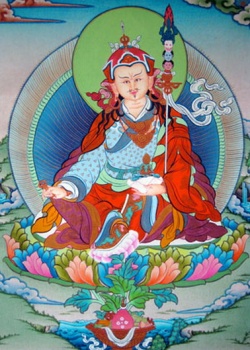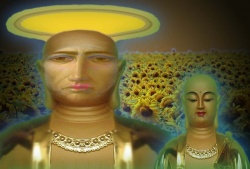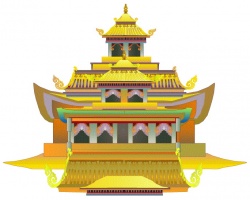Tibetan Zhentong Discourse II
Submitted by Michael R. Sheehy on Mon, 2008-12-08 14:33
Kongtrul also lists Rangjung Dorje’s and Dolpopa’s contemporary, the celebrated Nyingma master Kunkhyen Drimé Odzer or Longchen Rabjam (1308-1363).
Longchenpa does use similar terminology but in a context and with an implication different from that of Dolpopa.
However, Longchenpa’s view on the tathāgatagarbha does closely resemble that of Dolpopa’s, and his elaborations on the multi-stratum universal ground are remarkably similar to Dolpopa’s understanding of pristine awareness as the universal ground (kun gzhi ye shes).[1]
Serdok Paṇchen otherwise known as Śākya Chokden (1428-1507) is probably the most well-known non-Jonangpa author of zhentong.
Fortunately, the views of this Sakya exponent of zhentong gained the attention of Tāranātha, and were compared with the views of Dolpopa in Tāranātha’s text on the Twenty One Profound Points Differentiating the views of Śākya Chokden and Dolpopa]],
The great paṇḍita named Śākya asserts that nondual pristine awareness is not singular but is of multiple modalities, and is not constant since it does not remain dwelling for even an instant.
The omniscient Jonangpa Dolpopa asserts that although in actuality this [[nondual] pristine awareness is definitively not either singular nor multiple, a presentation of it as singular within certain contexts is correct; and it is constant because it is asserted to be indivisible, all-pervasive, free from constructs, and beyond expressions.
In sum, their particular assertions are that it is not constant or constant respectively.[2]
Though there are a variety of differences to explore and splice in views of these masters, Tāranātha assures us that the primary distinction to be made between them is that while Śākya Chokden accepts nondual pristine awareness (gnyis med kyi ye shes) to be impermanent or not constant (mi rtag pa),
Dolpopa asserts that nondual pristine awareness is perpetually pervading, and therefore is permanent or constant (rtag pa).
With this in mind, it is worthy to note that Tāranātha does include Śākya Chokden in his supplication to the Zhentong Madhyamaka and that he is accepted among the Jonangpa as one who upheld the zhentong tradition.[3]
The last proponent of zhentong philosophical thinking that deserves to be mentioned in this brief account is the Nyingma master Ju Mipham Gyatso (1846-1912).
A disciple of Kongtrul and Jamyang Khyentse Wangpo (1820-1892), Mipham was deeply influenced by their assimilation of zhentong thinking into the Rimé movement.
While it is evident that Mipham was sympathetic to some of the underlying tones presented in Dolpopa’s zhentong, he did not align his views strictly with that of Dolpopa and went to great efforts to juxtapose zhentong with rangtong ― using them as markers for ontological extremes.[4]
The Sakya scholar Remdawa Zhonu Lodrö (1349-1412) was probably the most adamant opponent of Dolpopa’s views after his passing.
His immediate disciple was the founder of the Geluk tradition, the famed Tsongkhapa Lozang Drakpa (1357-1419) whose critique of the zhentong view sparked a polemic debate that rages on to this day within the Tibetan rangtong / zhentong discourse.
After Tsongkhapa, the major opponent of Dolpopa’s views was Śākya Chokden’s rival in the Sakya tradition, Gorampa Sonams Sengé (1429-1489).
Identifying Dolpopa’s zhentong view with Cittamātra, Gorampa went so far as to suggest that the Jonangpas are extremists who were not only not Madhyimakins but not even Buddhists.[5]
Endnotes:
1. This is the second part of the previous post, Tibetan Zhentong Discourse I. See Karmay, S.G. The Great Perfection: A Philosophical and Meditative Teaching of Tibetan Buddhism, 184-5. Leiden: Brill, 1988.
2. Tāranātha. Zab don nyer gcig pa. In Rje btsun Tā ra nā tha’i gsung ‘bum, 18, 209-22. ‘Dzam thang. See also Mathes, K.D. 2005. "Tāranātha's Twenty-one Differences in Respect to the Profound Meaning: A Possible Starting-point for Studies in the Gzhan stong Madhyamaka." In JIABS, 278-321.
3. Tāranātha. "Supplication to the Profound Zhentong Madhyamaka Lineage." Michael R. Sheehy (trans). In Jonang Foundation's Digital Library, www.jonangfoundation.org/translations, 2007.
4. See Kapstein, M. "We Are All Gzhan stong pas: Reflections on the The Reflexive Nature of Awareness: A Tibetan Madhyamaka Defence by Paul Williams. In Journal of Buddhist Ethics, 7, 116, 2000.
5. Cabezon, J. "Freedom From Extremes: Gorampa’s ‘Distinguishing the Views’ and the Polemics of Emptiness," 51. Boston: Wisdom Publications, 2007.
Source
http://www.jonangfoundation.org/blog/tibetan-zhentong-discourse-ii



